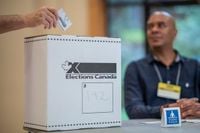As Canadians head to the polls today, April 28, 2025, the nation braces for the outcome of its snap federal election, called on March 23 amid rising tensions and a trade war with the United States. This election marks a pivotal moment, with a new federal government expected to be named by tonight, as the country’s political landscape is set to shift.
Voters across Canada are casting their ballots for one of the six main parties vying for the 343 seats in the House of Commons: Mark Carney’s Liberals, Pierre Poilievre’s Conservatives, Jagmeet Singh’s New Democrats, Elizabeth May and Jonathan Pedneault’s Greens, Yves-François Blanchet’s Bloc Québécois, and Maxime Bernier’s People’s Party of Canada. Polls are open from 7 a.m. to 7 p.m. in British Columbia and from 7:30 a.m. to 7:30 p.m. in Alberta, with similar hours across the country.
In British Columbia, where the stakes are particularly high, candidates are competing fiercely. In the Victoria riding, voters have the option to choose from candidates including Laurel Collins (New Democratic Party), Michael Doherty (Green Party), and Will Greaves (Liberal Party), among others. Each candidate brings a unique perspective to the table, reflecting the diverse political landscape of the region.
Meanwhile, in Alberta, the Red Deer riding features candidates such as Elias Assefa (New Democrat Party) and Burton Bailey (Conservative Party of Canada). Voters in the area are encouraged to verify their polling locations through the Elections Canada website or by using their voter registration cards.
In Langley, the competition is equally intense, with candidates like Aeriol Alderking (People’s Party of Canada) and Sukhman Singh Gill (Conservative Party of Canada) vying for votes. The Langley Advance Times has provided extensive coverage of the candidates, highlighting their responses to key questions posed by the community.
The Nanaimo-Ladysmith riding is creating buzz as it features the same candidates as the 2021 election, setting the stage for a dramatic finish. Incumbent Lisa Marie Barron (NDP) narrowly won in 2021 with 28.8% of the vote over Conservative Tamara Kronis (27.1%) and former Green MP Paul Manly (25.7%). With the 338Canada opinion poll aggregator projecting a close race, the outcome remains uncertain.
Nanaimo Mayor Leonard Krog expressed optimism about the quality of candidates, stating, “Nanaimo is going to get good representation regardless of who gets elected.” He emphasized that all candidates meet a high standard of experience and capability, which is a rarity in elections.
Political scientist David Black noted that if 2025 turns out to be a red-wave election for the Liberals, it could lead to increased competition and vote-splitting behavior in various ridings. This could result in unexpected outcomes, reflecting the complexities of Canadian politics.
As the election unfolds, candidates are addressing critical issues that resonate with voters. Barron highlighted concerns about affordability and the impact of Conservative leader Pierre Poilievre’s policies on everyday Canadians. She stated, “We need more people from our communities who understand what it’s like to work hard and still not be able to make ends meet.”
On the other hand, Liberal candidate Michelle Corfield, a member of the Ts’uubaa-asatx First Nation, emphasized the importance of electing someone who can influence policy decisions. “I’m fighting for every single individual in this riding to have a seat at the table with the governing body,” she asserted, advocating for the need for representation in government.
Conservative candidate Tamara Kronis has been vocal about her criticism of the current government, arguing that the NDP-Liberal coalition has put Canada at risk with reckless spending. She advocates for a “common sense” Conservative plan that prioritizes economic recovery and public safety.
As the polls close tonight, Canadians will be watching closely to see how the political landscape transforms in the wake of this election. With the stakes higher than ever, the outcome will shape the future of the country, particularly in light of the ongoing trade tensions with the United States.
For those still uncertain about where to vote, Elections Canada has made it easy to find polling locations. Voters can visit the Elections Canada website and enter their street address or consult their voter registration cards for details. It is essential for voters to bring proper identification to prove their identity and address, ensuring a smooth voting process.
As the day progresses and results begin to roll in, Canadians can expect comprehensive coverage of the election outcomes and analysis of what the results mean for the future of the nation. With various parties vying for power, the implications of this election will undoubtedly have lasting effects on Canadian society and governance.
In summary, as Canadians engage in this democratic process, the importance of their vote cannot be overstated. The 2025 snap election stands as a testament to the resilience of the Canadian political system, and the choices made today will echo in the halls of power for years to come.






